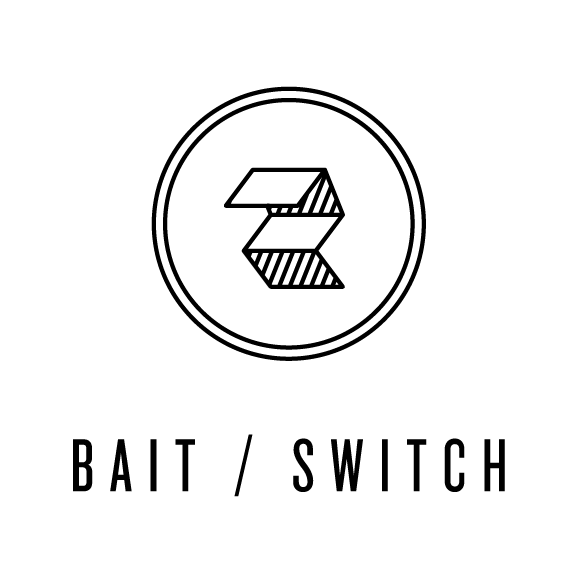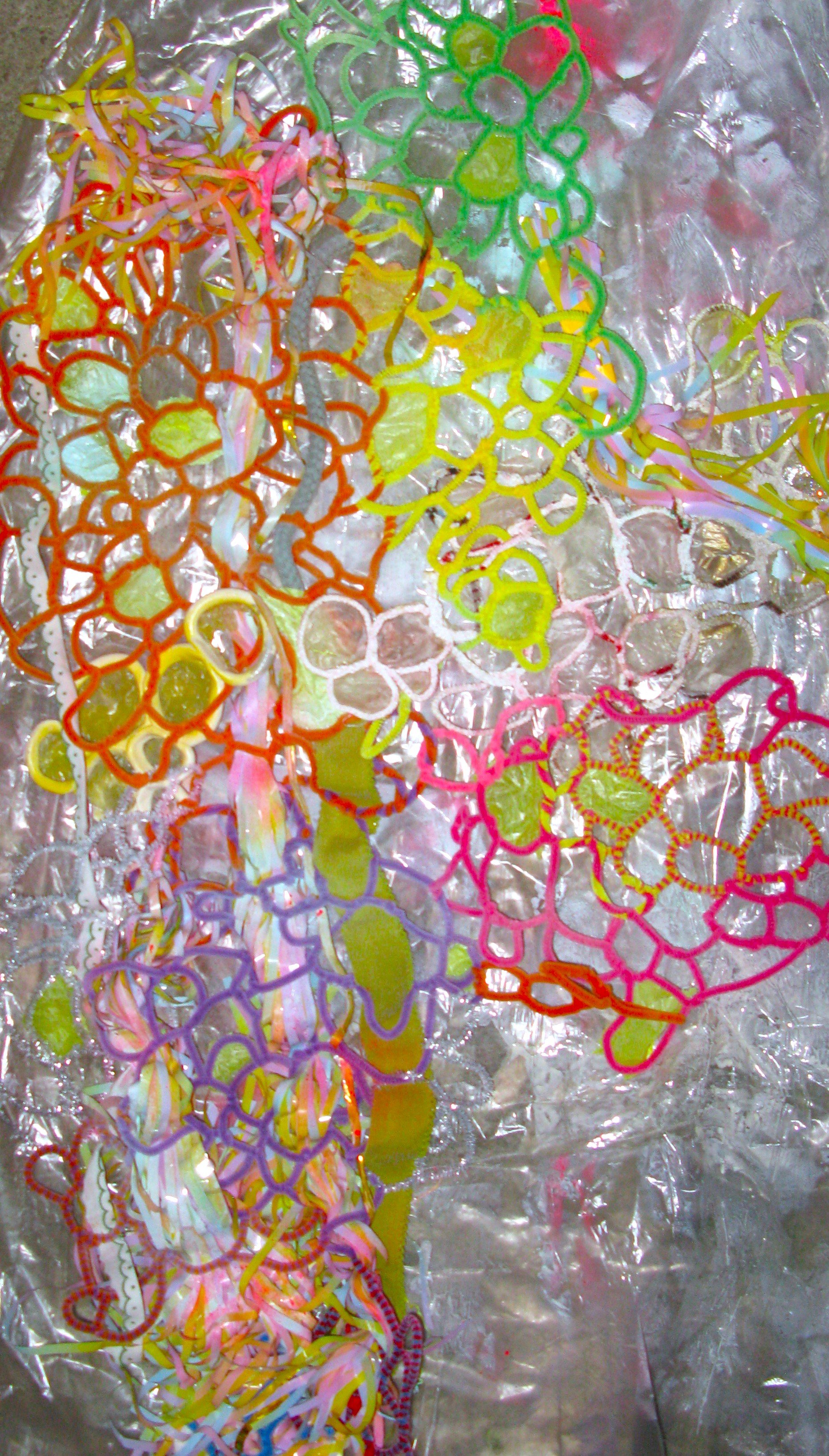Where It Begins and Ends
Melissa Diaz
“I kept thinking about what moves away from the wild, vibrant colors and brings it to calmer waters.”
Interview by L. Valena
December 30, 2022
Can you start by describing the prompt that you responded to?
I responded to a song. I initially started by listening to it a few times, but then I didn't want to listen to it too much and overthink the process. I was really interested in the rhythm of the song. It really had this in-and-out, meditative rhythm, and these lyrics around, “If I sit, maybe the pain will stop.” It made me think of so much of the push/pull of the pandemic. Figuring out what to do with our bodies, and what to do next. So that's where I started.
And where did you go from there?
I went with a familiar material. I utilize pipe cleaners a lot. I'm an art therapist, and somewhere within the past thirteen years of doing this work I just started using the materials I was using in my art therapy practice. I just was like, "Why am I using fine art materials, when this is what I'm providing to the individuals that I'm working with?" So I started with that, and it's a pretty meditative process for me, and the song kind of had that meditative quality. So I kind of started with that, creating a framework. There was also kind of a haunting quality to the song. I work with really bright colors, and it's kind of hard to tell in the image, but I was trying to figure out how to kind of subdue the colors and work with some of the darker undertones of the music.
After the initial pipe cleaner framework, I knew I wanted to weave things through, but I didn't want them to be the same colors as the colorful pipe cleaners. There was this greyish feeling that I was getting from the music. So I found some fabric scraps that I had that were more neutral colors. Some whites, some greys. And then I also had these old party streamers, that were kind of this subdued rainbow color. You know how when it's raining, and you look down at a puddle and there's a little rainbow? They give that feel. I know that my natural inclination is to go to these really bright colors that I'm usually more comfortable with, but I also wanted to be mindful that I'm responding to the song. So I kept thinking about what moves away from the wild, vibrant colors and brings it to calmer waters.
You said the song reminded you of that question of what to do with our bodies in the context of the pandemic. Can you say more about your experience around that?
Sure. I think for a lot of creative folks, and other friends I've talked with, it's kind of an interesting coming back. Maybe getting back to our studio practice. For myself, I've been tiptoeing back into it. Actually, applying to work on this project was my, "I need some deadlines, I need some reasons to get back into my practice." I feel like the pandemic has left us in a place of uncertainty, and definitely jolted our practices, whatever they may be. So how do we sit in that? How do we accept that? How do we know that we can't necessarily come back to the exact person that we were three years ago? How can we accept that, and still create and get back to a practice? That's kind of how I'm relating to it. Having spoken to other creative people, it's an interesting question. Is it safe? How do we get back? We're all relearning our process in a different way.
I've been talking to a lot of people about this, and it also seems like there is a feeling of being able to let go of the practices that weren't serving us as we find our way back. But that is also terrifying.
I think for me, I kept waiting for my old self to come back. I thought I would just come back, and apply to shows. And she just didn't come back. Accepting that there might be a different path, and kind of mourning what we've lost in that time. I think that goes back to the song. This idea of radical acceptance, and moving through, but maybe we don't know the path the way we used to. It's hard. I just want to go back, but I'm in a totally different part of my process now.
I want to hear more about the process that went into this piece.
The pipe cleaners create this lattice. It's almost a process of filling in the gaps. Some of the weaving and tissue paper fill in some of the circular forms, and make it more of a stained glass. Then the spray paint came in because I really wanted to use colors that I felt were coming from the music, and subdue some of the colors I was working with. I spray painted it a bit with a really light aqua color, and then over that with some white. Then I felt like I had washed it out too much, so I brought some splashes of pink in there. I was being mindful of reacting to the piece. I wanted to honor the song, and whoever created it, and it just didn't seem like my regular go-to colors fit. Filling in those gaps, stripping some of those super bright colors away, trying to give it more of a unity, more of a subdued color.
It sounds like you have a really developed and specific process for making this work. How long have you been doing this?
I've always been working with alternative materials. I used to work a lot with chicken wire, and making big sculptural forms. And then the pipe cleaners kind of stood in for that, making my own fencing or lattice to build a structure in a more flexible way. More like a tapestry form, that's still mirroring the beehive quality of the shape. I've done a lot of work with micro- and macro-environments, things that people can walk into or engage with. I've been doing this process with the woven texture for maybe ten years. And it really is a nice way to just get into the zone. I can do it with music by myself, or I can do it to just give my hands something to do when I'm watching something. It's also portable. Even with this piece, I did some of it at work while I was waiting for calls to come in, I did some of it at home. So it's also a mobile practice because it's such a lightweight material. I think it's also an extension of an automatic drawing. You don't really know where it's going to go, you're just letting yourself doodle, almost. But in a more three-dimensional form.
Allowing something to come through seems like a really important component of art therapy. It's cool that you've found a way to regularly bring that into your own process as an artist.
It's definitely a body of work that's my own mindfulness process. I have other bodies of work that are more thought out; I have this series of creating what I call Rad Rocks. They're inspired by gems and crystal healing, and I make my own funky rocks. It's much more about thinking about what the object is going to be, and with these it's much more about the process. And then through that, the surprises of where to go next, what to add. So it's definitely therapeutic in that way, and it's something that's easy to come back to when I'm between works or at a loss for where to get started. It usually helps inspire other types of work.
Is there anything about this piece or about your process that we haven't talked about yet?
This was really cool. It was nice to utilize a safe material for myself, but push myself in a different direction by not being singular, and allowing it to be a collaboration. I've done plenty of collaboration before, but to be collaborating with a piece, rather than a person, was really special. So I was considering how to honor the other person on the other side.
One thing that I've found so powerful about this work, is that the conversations that we have with each other's art is really different from the conversations we would have with each other as humans. It's like our art gets to talk to each other, and we're just the ones showing up and facilitating it.
It's nice. It gets to nurture that part of ourselves. When I think of art therapy, it's about communicating without the need for words. It kind of mirrors that.
Do you have any advice for another artist approaching this for the first time?
To not overthink it. Let yourself have fun with it, and have fun imagining who the other artist may be, what their practice is like. I definitely was mindful of trying to not get too much into my head about responding in a literal way.
Call Number: M63MU | M65VA.diaWhe
Melissa Diaz is a Latinx artist, art therapist, educator & community arts organizer; she integrates these roles by threading wellness and inclusion throughout. Melissa primarily works in interactive installation art, exploring inner (intrapsychic) & outer space (interpsychic), while highlighting the power of playful engagement. She holds 14 years of experience in Art Therapy, as a therapist, program director, and Creative Arts Therapy Instructor. In addition to her therapeutic practice, Melissa founded, Open House BK (estb. 2010), a Brooklyn based, community arts initiative; and continues to exhibit widely throughout the nation. Read more at https://www.melissadiazart.com/ and follow on Instagram at @m_diaz_art





